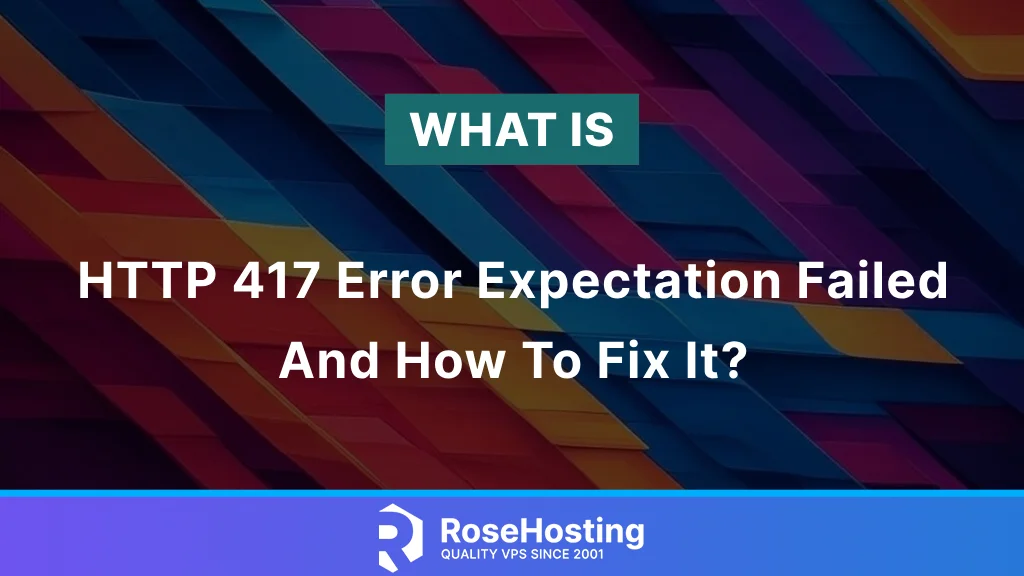
In this blog post, we will explain what the HTTP 417 Expectation Failed error is and how to fix it. The HTTP 417 Expectation Failed error occurs when the server can not fulfill the expectations set by the client in the Expect header of the HTTP request. The Expect header field in the request indicates a specific set of expectations that the server must support to handle the request successfully. In the following paragraphs, we will provide a more detailed explanation of the HTTP 417 error. We’ll discuss its causes and potential solutions.
The steps for fixing the HTTP 417 are straightforward. For this tutorial, you will need approximately 10 minutes to read and understand the material. Let’s get started!
Table of Contents
What is the HTTP 417 Error?
The HTTP 417 Expectation Error falls within the HTTP 400 status code family and is typically a server-related issue. It occurs in the browser when the server is unable to handle the request because the set of behaviors (expectations) in the request header is not fulfilled. For example, a client sends a request with an Expect header and waits for the server to respond. The server checks the header and if everything is okay, it will generate a response, called 100 Continue. Then, the client can send the message body. Otherwise, the server sends a 417 Expectation Failed response if it is unable to meet the expectations. This results in the HTTP 417 Error message in the browser.
What causes the HTTP 417 Error Expectation Failed message?
There are several causes for this error to appear in the browser. These will be explained in the next paragraphs of this section.
Server Misconfiguration is one of the causes for the HTTP 417 message to occur. That means that the server is not configured properly to understand and support specific expectations listed in the Expect header of the request.
Using a proxy can sometimes cause the removal of the Expect header in the request sent by the client, resulting in an immediate HTTP 417 Error. No Expect header, no response from the server.
Unsupported and Unrealistic Expectations sent by the client are also referred to as client errors.
Outdated Server Software or an old EOL OS on the server can lead to an HTTP 417 error. This occurs because older versions may not be compatible with the client’s expectations, as listed in the Expect header of the request.
How do I fix this error?
Several possible solutions to address this issue are outlined in the following paragraphs.
Disable Proxy if you are using one, or check if the proxy is not altering some of the Expect header parameters. You may choose not to disable the proxy.
Check the Server Configuration and ensure that the server settings are correctly configured to understand the client’s expectations as indicated in the Expect header.
Update the system packages or the software on the server. Update the OS to the latest version, as outdated software often fails to meet the client’s expectations, especially when using the latest versions of browsers.
Modify the Expect header in the request if the server does not support the expectations. It is even possible to remove the Expect header in the browser developer tools. In future versions of some browsers, the Expect header is considered to be deprecated.
Client-side adjustments are sometimes needed from the client side. This involves sending realistic and supported expectations. This ensures the server can understand them and return a non-HTTP 417 message.
How does it affect your SEO?
SEO, or Search Engine Optimization, is the practice of improving a website’s visibility in search engine results pages, such as Google. The HTTP 417 error can negatively impact a website’s SEO by negatively affecting the user experience, which can lead to user frustration. The user will immediately leave the website if there are repeated HTTP 417 Errors. Due to this error, the website will become inconsistent. It will then be de-indexed by search engines, resulting in a significant loss of organic traffic.
Conclusion
The HTTP 417 status code error message occurs when the server can’t meet the expectation in an HTTP request’s Expect header. This status code is not common and could appear very rare. However, when it does, it can affect website functionality, user experience, and negatively impact SEO
That’s it. You learned some basic steps to fix the HTTP 417 Error: Expectation Failed. If you are not familiar with Linux, you can contact our technical support for assistance. To get started, sign up for our Linux NVMe VPS plans and submit a support ticket. We are available 24/7 and will be happy to assist you.
If you liked this post about the HTTP 417 Error Expectation Failed and how to fix it, please share it with your friends or leave a comment down below.